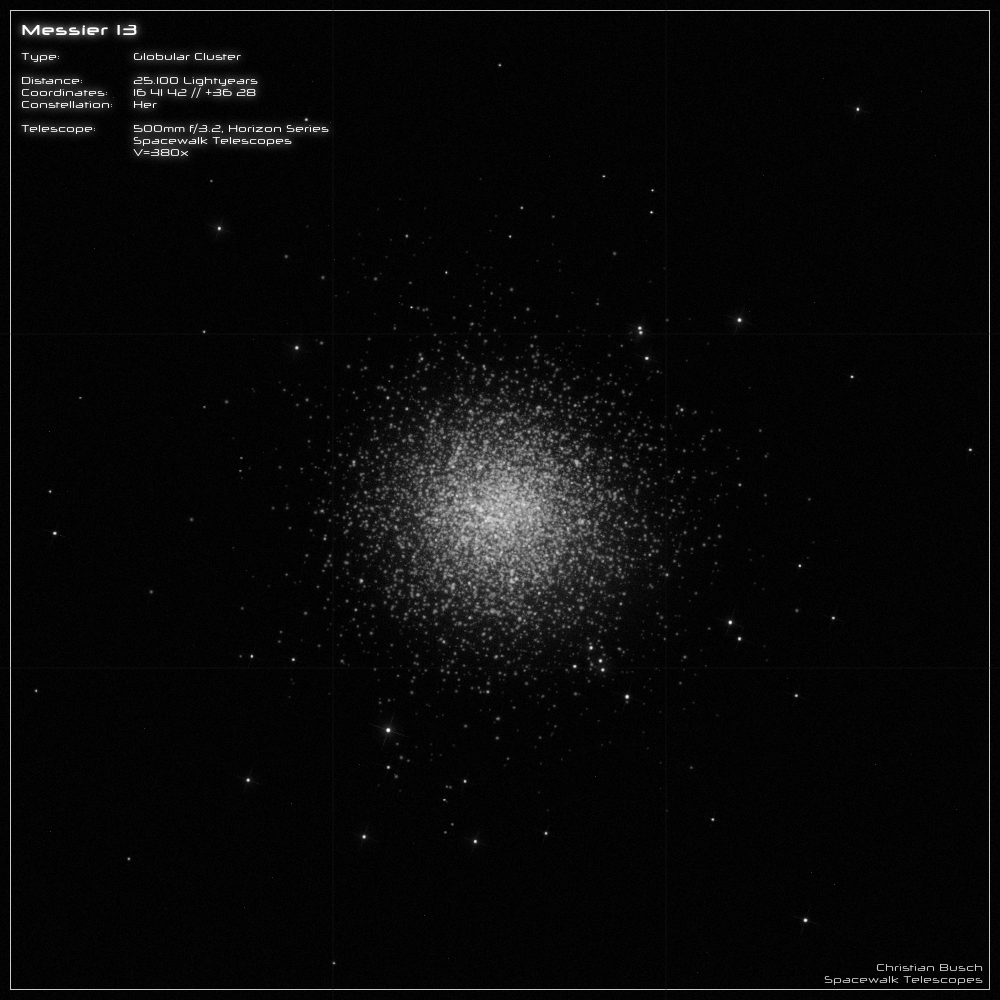Messier 13 - Globular Cluster
With an apparent brightness of 5.8mag and an angular extent of 20', Messier 13 is the largest and brightest globular cluster in the northern sky
and can be seen best in spring and summer, when it culminates high above our heads. When the sky is particularly dark, it can even be seen with
the naked eye as a diffuse spot in the constellation of "Hercules".
Because of its brightness, it was discovered as early as 1714 by Sir Edmond Halley. 50 years later, Charles Messier was also able to observe the
globular cluster, but was unable to resolve it into individual stars with his small telescope. This was achieved by F.W. Herschel in 1783. The first
photograph of M13 was taken in Paris in 1887, which was able to resolve the cluster into individual stars at the edge, but only partially resolved
the dense core.
Messier 13 is 25,100 light-years away from Earth and has a diameter of 150 light-years. Of this, the innermost 50-60 light-years are visible in a
telescope, while the extended halo is not really perceptible. It is assumed that this Globular contains up to half a million stars with a total mass of
600,000 to 775,000 solar masses. The density of stars in the core of the cluster is over 100 times higher than in the vicinity of our solar
system. Try to imagine what the sky would look like on a hypothetical planet in the center of M13: it would be littered with thousands of very bright
stars and quite a few of them would shine with an apparent brightness of -10mag to -13mag (i.e. brighter than the full moon). It would probably not
get dark any more at night.
All the stars together give the globular cluster an absolute brightness of M= -8.5mag, which corresponds to a luminosity of 215,000 suns. The
brightest star is designated “V1554 Her” or “V11”. It is a variable red giant star, which has a brightness of m=11.95mag and shines 840 times brighter
than our sun. So far, 65 variable stars are known in M13, the last one was discovered in January 2024. The stars themselves are very metal-poor and
contain on average only 4.6% as much iron as the Sun - so they belong to the class of "Population II" stars. This in turn indicates a very high age,
which is 11.9 billion years for Messier 13. A special class of stars are the so-called “blue stragglers”, which were formed by the collision + merger of
two stars due to the immensely high stellar density.
Messier 13 is moving towards Earth at a speed of v= 246km/s - so it takes around 1,200 years to get 1 light-year closer to us.
----------------------------------------------------------------------------------------------------------------------------------------------
In my 20” telescope, Messier 13 offers a really beautiful sight that can hardly be descriped. :))
This large Globular Cluster can be resolved down to the core even at a magnification of 120x. However, it appears most beautiful at a magnification of 380x,
when the bright sphere of hundreds of individual stars fills a large part of the field of view. Also striking are individual star trails that extend outwards like
arms, as well as a well-known feature in the core area where the stars form the letter “Y”. When the seeing is very good, the space between the brighter stars
appears clearly grainy and you get a feeling that there is an extremely large number of very faint stars here, making the view appear three-dimensional.
I don't want to write much more about the view, but rather let the drawing speak for itself (although this is not yet complete, because I looked for conspicuous
star trails on another night and narrowed down the extent of the halo more precisely).

